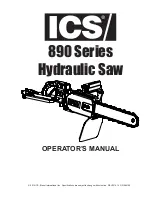
●
When the saw reaches full speed, push the main
operating handle (2) down slowly, cutting through the
leading edge of the workpiece.
●
Slowly move the main operating handle (2) toward the
fence to complete the cut.
● Release the on/off switch (3) and allow the blade to stop
before allowing the cutting head to rise.
Chop cut (fig. J & K)
●
Slide the cutting head to the rear position as far as it will
go, and lock the carriage (29) with the lock knob (48).
● Operate the on/off switch (3) and press the saw arm
release lever (36) to lower the cutting head.
●
When the saw reaches full speed, push the main
operating handle (2) down slowly, cutting through
the workpiece.
●
Slowly move the main operating handle (2) toward the
fence to complete the cut.
● Release the on/off switch (3) and allow the blade to stop
before allowing the cutting head to rise.
Mitre cut (fig. B & K)
● Switch the laser on/off switch (1) to on.
●
Loosen the mitre detent lever (11) and move the table
to the required angle. There are preset stops at 0°, 15°,
22.5°, 31.6°, and 45°. Tighten the mitre detent lever (11).
● For any other angle use the mitre clamp (9) (fig. B) to set
the mitre to the required angle.
● Operate the on/off switch (3), then press the saw arm
release lever (36) and lower the cutting head.
●
When the saw reaches full speed, push the main
operating handle (2) down slowly, cutting through
the workpiece.
●
Slowly move the main operating handle (2) toward the
fence to complete the cut.
● Release the on/off switch (3) and allow the blade to stop
before allowing the cutting head to rise.
Operating the high sliding fence for all bevel and
compound mitre cuts
●
The moveable part of the left side of the fence can be
adjusted to provide maximum support of the work piece
near the blade, while allowing the saw to bevel to a
full 47° left. The sliding distance is limited by stops in
both directions.
Adjusting the fence (fig. E)
●
Loosen the high sliding fence clamp (20) and slide the
fence to the left.
●
Make a dry run with the saw switched off and check
for clearance.
●
Adjust the fence to be as close to the blade as practical to
provide maximum work piece support, without interfering
with the up and down movement of the arm.
●
Tighten the high sliding fence clamp (20) to secure the
fence in place.
@
Warning!
The guide groove can become clogged
with sawdust. Use a stick or low pressure air to
clear the guide groove.
Bevel cut (fig. F)
●
Make sure that the high sliding fence is adjusted to the
correct orientation before adjusting the bevel angle.
Note:
The saw is fitted with a special 33.9° bevel pin (23) for
special crown moulding.
● Loosen the bevel lock handle (30) (fig. F) and move the
cutting head to the required angle. Tighten the bevel lock
handle (30).
● Operate the on/off switch, then press the release
lever (36) when the saw reaches full speed, push the
main operating handle (2) down slowly, cutting through
the workpiece.
●
When the saw reaches full speed, push the main
operating handle (2) down slowly, cutting through the
leading edge of the workpiece.
●
Slowly move the main operating handle (2) toward the
fence to complete the cut.
● Release the on/off switch (3) and allow the blade to stop
before allowing the cutting head to rise.
●
Make sure that the arm is securely locked when bevelling.
Compound cut (fig. K)
●
Make sure that the high sliding fence is adjusted to the
correct orientation before adjusting the bevel angle to
make a compound cut.
A compound cut is a combination of mitre cut and bevel cut.
● Switch the laser on/off switch (1) to on.
●
Refer to the above procedures to perform this cut.
●
When the saw reaches full speed, push the main
operating handle (2) down slowly, cutting through the
leading edge of the workpiece.
●
Slowly move the main operating handle (2) toward the
fence to complete the cut.
● Release the on/off switch (3) and allow the blade to stop
before allowing the cutting head to rise.
Base moulding cut
Base moulding can be cut vertical against the fence or flat on
the table.
●
Refer to the following table:
Settings
Vertical position
(back of moulding is
against the fence)
Horizontal position
(back of moulding is
flat on the table)
Bevel angle
0 º
45 º
Moulding position
Left side
Right
side
Left side
Right
side
13
ENGLISH
(Original instructions)
Summary of Contents for FatMax FME720
Page 1: ...www stanleytools eu www stanley eu FME720 ...
Page 3: ...A 3 ...
Page 5: ...5 H I J K L M 29 33 9 31 6 ...
Page 6: ...6 N O P Q R ...
Page 142: ...142 ...
Page 143: ...143 ...














































